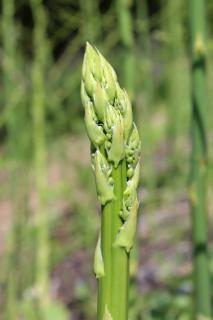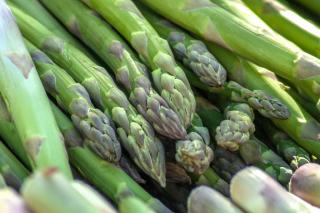

Asparagus is a delicate-tasting vegetable and growing it means paying attention to a few things.
Simple asparagus facts
Name – Asparagus officinalis
Family – Asparagaceae
Type – vegetable, perennial
Height – 30 to 55 inches (80 to 140 cm)
Exposure – full sun
Soil – light, well-drained
Harvest – In spring, when the shoots sprout from the ground

There are 2 main types of asparagus:
You can grow both types in exactly the same manner.
During the months of February to April, it is important to plant asparagus in rows, preferably aligned with dominant winds.
Asparagus is demanding and it is necessary to fertilize the ground beforehand.
Plant asparagus thanks to young root clumps grown from seeds, called “crowns”.
If you’re preparing seedlings, wait for a year before putting them in place.
Asparagus needs 2 years to grow since harvesting isn’t possible during the first year.
To speed things up, it is possible to purchase plants that are already 2 years old.
Once well settled-in, you’ll be able to harvest your asparagus for over 15 years.
As for watering, asparagus needs water on a regular basis but hates sitting water.
Asparagus must be harvested while still tender, and you cut it off with an asparagus knife.
The best time to harvest asparagus is from April to June. Harvest shoots with a long blade-tipped tool called an asparagus knife.
Tip: It is best to wait a full 3 years before harvesting your asparagus, to let the plant develop during the first years of its life.

Asparagus grown today were bred from an ancestor called medicinal Asparagus.
The taste of asparagus essentially depends on the type of soil and organic matter content.
Clay and loamy soils will give it a rather bitter taste.
Together with the green and white varieties, you’ll find a couple others, too:
To taste them at their best, eat them quickly after they’ve been cut.
<!–silent
–>
Add compost in fall to increase availability of nutrients.
Hello it has been one year since I planted my asparagus, now they are like a toothpick. Shall I cut them at soil level or let them be? Thanks for your help.
Hello Pierre! If your asparagus are sticking out of the soil as tall as a toothpick, you can already harvest a a few for fun, but it would be best to wait another two years for the plant to grow. If its your first time, try and dig some soil out carefully to have an idea of where the shoot is starting off from. If you wait too long the shoots will get fibrous. It’s ok to harvest until end of June but after that you must let the plant live from its leaves to grow strong for next year.